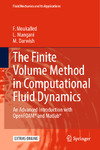| dc.description.abstract | The impetus to write this book came about from three sources:
The first source was the bi-yearly computational fluid dynamics (CFD) course,
which has been offered over the last 15 years at the American University of Beirut
(AUB) by both Drs. Darwish and Moukalled to senior and graduate mechanical
engineering students, a course that focuses on the finite volume method (FVM) and
CFD applications.
The second source grew over the years to become more significant as it was
noticed that graduates have started working on increasingly more focused areas and
topics in CFD while becoming less cognizant of the general algorithmic expertise
that earlier students developed. It became clear that there is a need not only to cover
the basis of the numerics at the core of CFD codes but also to discuss the implementation
issues to ensure that all students receive a robust understanding of the
techniques they are working on.
Finally, the collaborative work in advanced numerics with Prof. Dr. Mangani
from HSLU, Lucerne, Switzerland, which started during the Ph.D. supervision of
M. Buchmyer (Ph.D.) from TUGraz, provided all the incentive to clarify and detail
much of the numerical basis of the algorithms used in OpenFOAM®.
To this end, it was decided that the book would combine a mix of numerical and
implementation details allowing the reader, if she/he desires, to fully understand
and implement a robust and versatile CFD code based on the FVM.
This ambitious task was possible only by selecting from the various numerical
methods in each of the topics covered in the book a handful set with which the
authors are intimately familiar. The result is a book that covers intimately all the
topics necessary for the development of a robust CFD code for the simulation of
fluid flow at all speeds within the framework of the collocated unstructured finite
volume method.
The book was also written with the classroom in mind as reflected by the use of
copious illustrations; the provision of many exercises covering numerics, programming,
and applications; the availability of an academic code (in MATLAB®)
that imbeds much of the numerics presented in the book; and finally the various
programs and routines in OpenFOAM®. | en_US |

